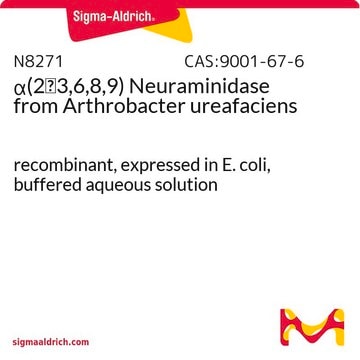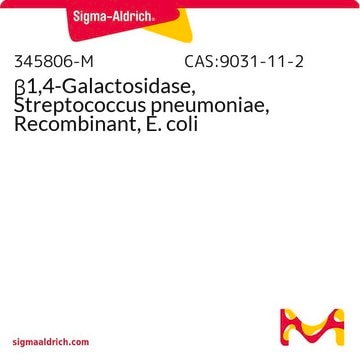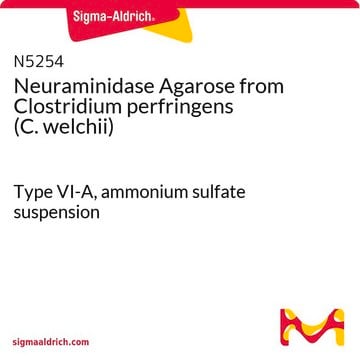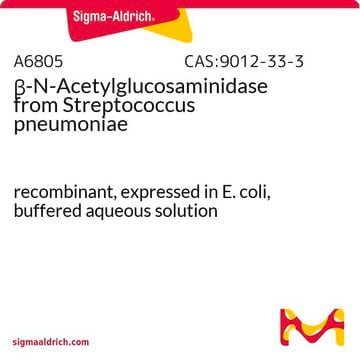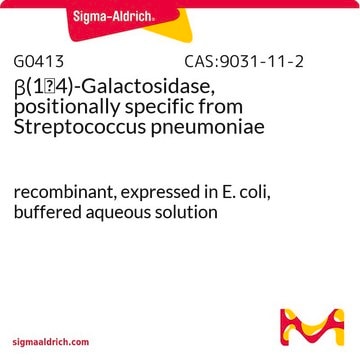It is shipped at ambient temperature, but it is to be stored at 2-8 °C for long term storage. Do not FREEZE as it is in a buffered aqueous solution.
Wichtige Dokumente
N7271
α(2→3)-Neuraminidase aus Streptococcus pneumoniae
buffered aqueous solution
Synonym(e):
Acyl-Neuraminyl-Hydrolase, Acylneuraminyl-Hydrolase, Receptor-destroying enzyme, Sialidase
Größe auswählen
1.060,00 €
Auf LagerDetails
Größe auswählen
About This Item
1.060,00 €
Auf LagerDetails
Empfohlene Produkte
Biologische Quelle
Streptococcus pneumoniae
Qualitätsniveau
Form
buffered aqueous solution
Konzentration
≥5 units/mL
Fremdaktivität
β-Galactosidase, α-mannosidase, β-hexosaminidase, α-fucosidase, and proteases, none detected
Versandbedingung
wet ice
Lagertemp.
2-8°C
Angaben zum Gen
Streptococcus pneumoniae R6 ... nanB(933504)
Biochem./physiol. Wirkung
Verpackung
Einheitendefinition
Physikalische Form
Angaben zur Herstellung
Signalwort
Danger
H-Sätze
P-Sätze
Gefahreneinstufungen
Resp. Sens. 1
Lagerklassenschlüssel
13 - Non Combustible Solids
WGK
WGK 1
Flammpunkt (°F)
Not applicable
Flammpunkt (°C)
Not applicable
Persönliche Schutzausrüstung
Eyeshields, Gloves, type N95 (US)
Hier finden Sie alle aktuellen Versionen:
Besitzen Sie dieses Produkt bereits?
In der Dokumentenbibliothek finden Sie die Dokumentation zu den Produkten, die Sie kürzlich erworben haben.
Kunden haben sich ebenfalls angesehen
Artikel
Understand sialic acid structure, function, signaling, and modifications. Easily find products for sialic acid research.
-
What is the long term storage and shipping condition of ?(2—›3) Neuraminidase, Product No. N7271?
1 Antwort-
Hilfreich?
-
-
What is the molecular weight of ?(2—›3) Neuraminidase, Product No. N7271?
1 Antwort-
The molecular weight of this ?(2—›3 Neuraminidase enzyme is approximately 75 kDa.
Hilfreich?
-
-
What are the reaction conditions of the enzyme ?(2—›3) Neuraminidase, Product No. N7271?
1 Antwort-
One nanomole of substrate or less can be cleaved in a 20 μL reaction volume. In the standard reaction use: 4 μL of 5X enzyme reaction "buffer B" (=250 mM sodium phosphate buffer, pH 6.0), a combined volume of 14 μL containing purified oligosaccharide and water and 2 μL of NANase I (N7271). Incubate 1 hour at 37 °C. To cleave more than one nanomole of substrate, increase reaction volume and enzyme proportionally.
Hilfreich?
-
-
For ?(2—›3) Neuraminidase, Product No. N7271, what is the optimum pH range for the neuraminidase enzyme activity?
1 Antwort-
The optimum pH range for ?(2—›3 neuraminidase is 6.0. Please see the data sheet.
Hilfreich?
-
-
What is the Department of Transportation shipping information for this product?
1 Antwort-
Transportation information can be found in Section 14 of the product's (M)SDS.To access the shipping information for this material, use the link on the product detail page for the product.
Hilfreich?
-
Aktive Filter
Unser Team von Wissenschaftlern verfügt über Erfahrung in allen Forschungsbereichen einschließlich Life Science, Materialwissenschaften, chemischer Synthese, Chromatographie, Analytik und vielen mehr..
Setzen Sie sich mit dem technischen Dienst in Verbindung.


